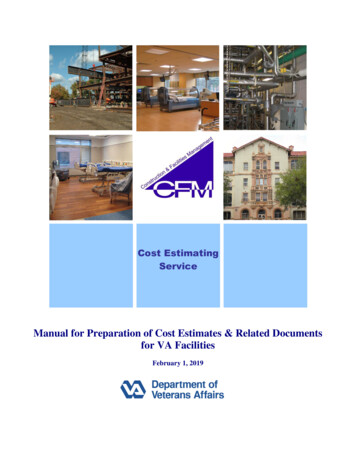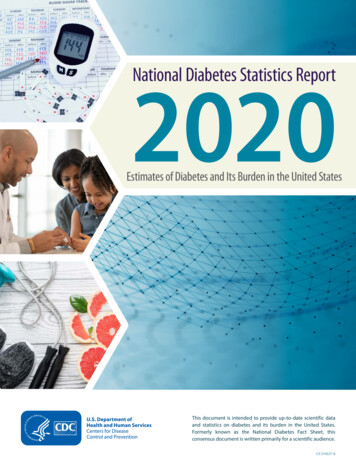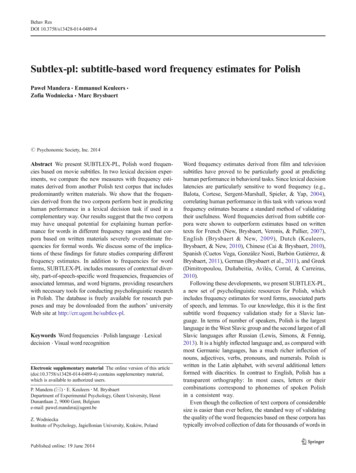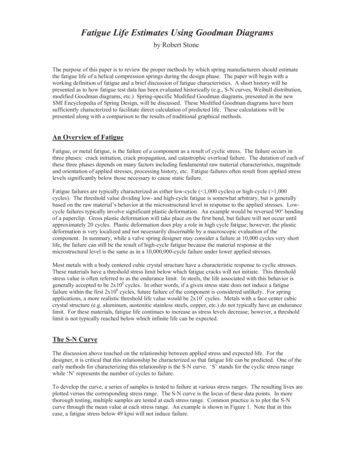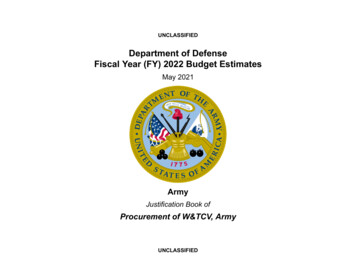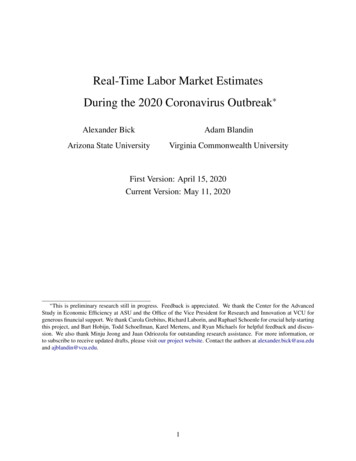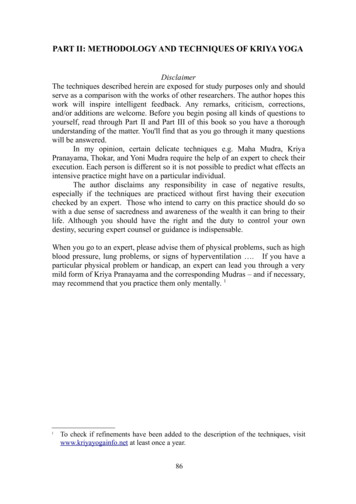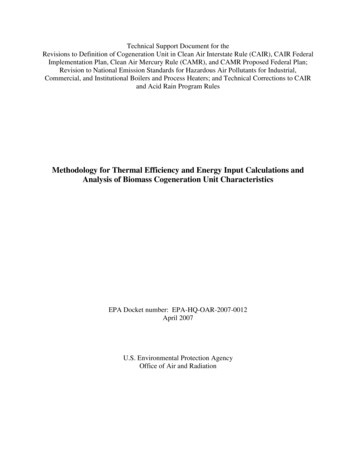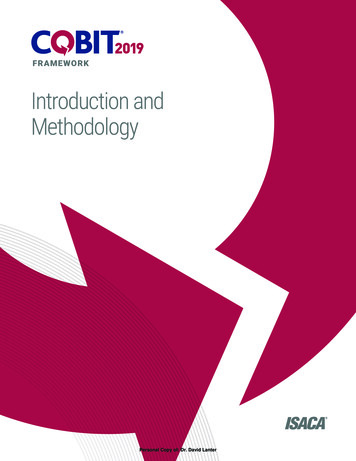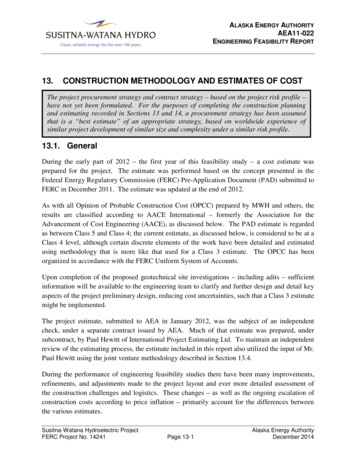
Transcription
ALASKA ENERGY AUTHORITYAEA11-022ENGINEERING FEASIBILITY REPORT13.CONSTRUCTION METHODOLOGY AND ESTIMATES OF COSTThe project procurement strategy and contract strategy – based on the project risk profile –have not yet been formulated. For the purposes of completing the construction planningand estimating recorded in Sections 13 and 14, a procurement strategy has been assumedthat is a “best estimate” of an appropriate strategy, based on worldwide experience ofsimilar project development of similar size and complexity under a similar risk profile.13.1. GeneralDuring the early part of 2012 – the first year of this feasibility study – a cost estimate wasprepared for the project. The estimate was performed based on the concept presented in theFederal Energy Regulatory Commission (FERC) Pre-Application Document (PAD) submitted toFERC in December 2011. The estimate was updated at the end of 2012.As with all Opinion of Probable Construction Cost (OPCC) prepared by MWH and others, theresults are classified according to AACE International – formerly the Association for theAdvancement of Cost Engineering (AACE), as discussed below. The PAD estimate is regardedas between Class 5 and Class 4; the current estimate, as discussed below, is considered to be at aClass 4 level, although certain discrete elements of the work have been detailed and estimatedusing methodology that is more like that used for a Class 3 estimate. The OPCC has beenorganized in accordance with the FERC Uniform System of Accounts.Upon completion of the proposed geotechnical site investigations – including adits – sufficientinformation will be available to the engineering team to clarify and further design and detail keyaspects of the project preliminary design, reducing cost uncertainties, such that a Class 3 estimatemight be implemented.The project estimate, submitted to AEA in January 2012, was the subject of an independentcheck, under a separate contract issued by AEA. Much of that estimate was prepared, undersubcontract, by Paul Hewitt of International Project Estimating Ltd. To maintain an independentreview of the estimating process, the estimate included in this report also utilized the input of Mr.Paul Hewitt using the joint venture methodology described in Section 13.4.During the performance of engineering feasibility studies there have been many improvements,refinements, and adjustments made to the project layout and ever more detailed assessment ofthe construction challenges and logistics. These changes – as well as the ongoing escalation ofconstruction costs according to price inflation – primarily account for the differences betweenthe various estimates.Susitna-Watana Hydroelectric ProjectFERC Project No. 14241Page 13-1Alaska Energy AuthorityDecember 2014
ALASKA ENERGY AUTHORITYAEA11-022ENGINEERING FEASIBILITY REPORTThe estimating tasks consisted of estimating the anticipated total cost of the project, focusing onthe construction costs and the OPCC, but also including the estimation of pre-constructionproject development activities, design and environmental work, various AEA costs, and the costof construction management and engineering during construction. Licensing, environmentalmitigation, owner’s management, and land costs were provided by AEA for inclusion in theoverall project estimate.The AACE classification system indicates the expected ranges of costs associated with itsclassifications. However, for this feasibility study probabilistic estimating practices were used,and an “adjusted” cost estimate was established accounting for possible price, quantity, and workscope variability in estimating. For the current estimate a “management reserve” has beensuggested as explained below, but this should be explored in more detail in the future. All costsfor the feasibility estimate are expressed in second quarter (Q2) 2014 US .The OPCC and project cost estimate described do not include financing costs, interest duringconstruction, or escalation. Those items will be included in separate financial planningdocuments being prepared by AEA.The standard term used in the industry for the estimate of construction cost – and used herein – isthe OPCC. Normally the OPCC is the estimated construction and equipment procurement cost(i.e., the expected successful bid price, including various allowances a bidder will always includefollowing its pre-bid assessment of “known unknowns”).Separately allowances for events and occurrences affecting cost after the commencement ofconstruction have not been made at this stage. It is prudent to perform a further probabilisticanalysis after the results of the current dam site geotechnical investigations and environmentalstudies are available, to address the possibility of unforeseen events impacting the “as built”project cost.The term “opinion” is important, as the estimating product represents – in many respects – anopinion based on a broad understanding of the construction industry. OPCCs presented herein,including evaluations of project budgets, and/or funding, represent MWH’s best judgment as adesign professional familiar with the construction industry. Such opinions or evaluations arebased upon current market rates for labor, materials, and equipment. Future costs of labor,materials, or equipment, construction contractor’s methods of determining bid prices,competitive bidding environments, unidentified field conditions, market conditions, hyperinflationary or deflationary price cycles, and other factors may affect the OPCC. It is importantto recognize that the OPCC is a “snapshot” in time and that the reliability of a given OPCC willdegrade over time. MWH cannot and does not make any warranty, promise, guarantee, orrepresentation, either express or implied that proposals, bids, project construction costs, or costSusitna-Watana Hydroelectric ProjectFERC Project No. 14241Page 13-2Alaska Energy AuthorityDecember 2014
ALASKA ENERGY AUTHORITYAEA11-022ENGINEERING FEASIBILITY REPORTassociated with future operation or maintenance will not vary substantially from MWH’s goodfaith OPCC as presented herein.For the 2013 round of project estimation, instead of an independent estimate, the methodology of“joint venture” estimating was implemented, using an independent estimator Mr. Paul Hewitt.Each party prepared a construction cost estimate completely independently, before meeting torationalize their independent estimates, line by line.Having rationalized their two estimates, a joint agreement was reached for the potential highsand lows for each line item, for the variability analysis.A key part of the estimating tasks early in the feasibility studies related to comparative costestimation of the type of dam and the number and capacity of the power plant generating units.The comparison of three different configurations of the project (based on three possible types ofdams considered for this site), was carried out during the first year of studies. A comparison ofthe three types (Earth Core Rockfill Dam, Concrete Faced Rockfill Dam, and roller-compactedconcrete [RCC]) was performed by estimating the construction costs of the facilities that are notcommon to the dam types. A separate layout was drawn for each type of dam and detailed asnecessary to determine the basic unit quantities associated with each development. The mosteconomic dam that performs with the appropriate level of safety was determined to be oneconstructed of RCC. This exercise is described in more detail in Section 7.A similar exercise was performed later in the development of the project configuration, based onthe comparison of three different potential unit sizes (3 x 200 MW @ water level El. 1950 ft.;and 4 x 150 MW and 6 x 100 MW at the same head, all resulting in a 600 MW nominal capacityplant – also compared was 3 x 200 MW @ normal maximum operating level). In thatcomparison, also described in Section 7, the common items were not estimated, but all civil andmechanical components associated with each alternative power facilities arrangement wereestimated and compared using proprietary MWH software, that prepares designs based onparametric algorithms.The following discussion is presented as five parts: Estimating methodology; Adopted construction methodology (forming the foundation of the estimate); The construction cost estimate; Non-construction costs;Susitna-Watana Hydroelectric ProjectFERC Project No. 14241Page 13-3Alaska Energy AuthorityDecember 2014
ALASKA ENERGY AUTHORITYAEA11-022ENGINEERING FEASIBILITY REPORT The total program cost estimate; and, The projected construction schedule (addressed in Section 14).All these aspects of project planning, particularly construction planning, are completelyinterwoven. The estimating methodology section contains general material with respect to theestimating process. The adopted construction methodology highlights the construction planning,logistics and methodology for the various parts of the work, broken down in the assumedcontracts. The construction and project cost estimate sections present the project team’s estimateand background on the respective construction costs and the estimated total project cost. Finally,the schedule section highlights the schedule assumptions and the key dependencies of theschedule.Due to the project scale, the limited amount of design work completed to date, and validationtime constraints, the Pareto principle was used to focus the pricing verification effort to the areasof significance, and aspects to which the project costs are particularly sensitive. The Paretoprinciple simply states that, when analyzing events or populations, approximately 80 percent ofthe effects will typically arise from just 20 percent of the causes. The 80/20 rule implies that afew (20 percent) drivers are vital and the many (80 percent) are trivial. Hence, typically a smallminority of events or results can significantly impact or drive a cost estimate’s bottom-line.Consequently, the analysis of the construction methodology and costs has been concentrated onthose areas having the greatest likelihood of cost significance and impact on the bottom lineproject cost.The principle was applied as a tool to decompose the significant amount of cost estimate detail,thereby expediting the definition and segregation of cost driver elements. Hence, for thepurposes of this validation exercise, a project cost driver is defined as a component of theminimum number of elements, within a specific feature of work, that approximate 80 percent ofthe feature’s total costs.This simplification has allowed the project team to focus on the major items of work or efforts(such as the logistics) that most affect the total cost of the project. These major items wereoptimized to the greatest extent possible at this stage, and have the greatest potential to reduceoverall project cost. These large cost items also will need additional scrutiny in ongoing projectdevelopment and future reviews of project cost for accuracy.Susitna-Watana Hydroelectric ProjectFERC Project No. 14241Page 13-4Alaska Energy AuthorityDecember 2014
ALASKA ENERGY AUTHORITYAEA11-022ENGINEERING FEASIBILITY REPORT13.2. Estimating Methodology – Construction13.2.1.Basis of PricingThe OPCC reflects the estimator’s opinion as to the probable costs that a “prudent” contractorwould include in the tender to construct the defined facilities.Pre-construction activities and expenses related to the management and support of fieldconstruction activities are included elsewhere in the reporting of estimated project costs. Theestimate of the required overall project investment cost consists of three discrete parts:1. Construction and equipment procurement (generally these are considered constructioncosts).2. Other activities required to implement the project (i.e., land acquisition, engineeringservices, legal, and project and financial management).3. An allowance for additional costs arising from uncertainties and unplanned risk eventswhich could occur on the project.The following sections address the derivation of the “construction cost” together with highlightsof allowances applied, followed by a discussion on the derivation of other project costs.13.2.2.Estimate ClassificationAs noted above, estimates are usually classified in accordance with the criteria established inAACE’s Cost Estimate Classification System, referred to as Recommended Practice 69R-12(AACE, 2013). The AACE Cost Estimate Classification System maps the various stages ofproject cost estimating together with a generic maturity and quality matrix, which can be appliedacross a wide variety of industries and capital infrastructure developments.This estimate is considered consistent with Class 4 classification criteria described by AACE as:“generally prepared based on limited information, where the preliminary engineering isfrom 1 to 15 percent complete. A Class 4 estimate is generally used for detailed strategicplanning, business development, project screening, alternative project analysis,confirmation of economic and or technical feasibility, and where preliminary budgetapprovals are needed to proceed. Examples of estimating methods used would beequipment and or system process factors, scale-up factors, and parametric and modellingtechniques.”Susitna-Watana Hydroelectric ProjectFERC Project No. 14241Page 13-5Alaska Energy AuthorityDecember 2014
ALASKA ENERGY AUTHORITYAEA11-022ENGINEERING FEASIBILITY REPORTFor comparison, a Class 3 estimate is described by AACE (particularly with reference tohydropower development) as:“typically form the initial control estimate against which all actual costs and resourceswill be monitored. Typically, engineering is from 10 percent to 40 percent complete, andwould comprise at a minimum the following: preliminary general arrangementdrawings, powerhouse, intake and spillway drawings and specifications, essentiallycomplete geotechnical investigations and hydrotechnical studies, preliminary earth
The construction and project cost estimate sections present the project team’ s estimate and background on the respective construction costs and the estimated total project cost. Finally, the schedule section highlights the schedule assumptions and the key dependencies of the schedule. Due to the project scale, the limited amount odesign work completed to date,f and validation time .
